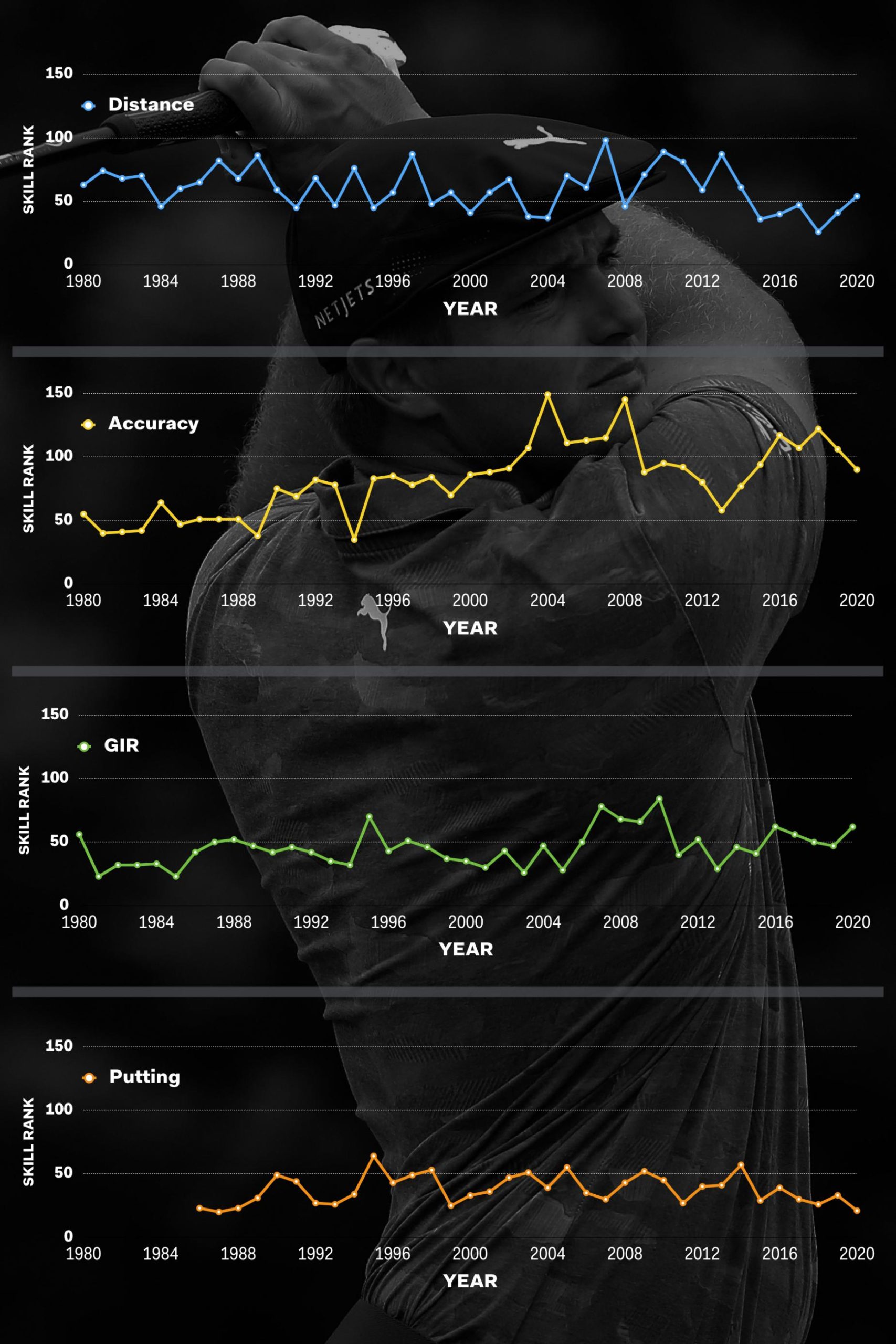The argument golf’s ruling bodies have been not so subtly making in recent years is that distance has become a distortion of the game. There are plenty of PGA Tour statistics to make this case, whether it’s the increases in average driving distance, the number of drives longer than 300 metres or the average clubhead speed on tour.
But whether those statistics mean the longest hitters are dominating the game in a distinctly different way than they have in the past, well, that’s a different question. And a different set of numbers show that big hitters indeed have begun to matter more than ever. Or at least they have until this year. In 2020, the numbers are saying big distance is generally about as relevant to success on the PGA Tour as it’s always been, not more and not less.
The ruling bodies have ramped up their study of distance in the past five years, including a comprehensive investigation of the topic called the Distance Insights Project that ultimately concluded that driving distance at the elite level needed to be curbed. The R&A and USGA haven’t tabled any specific recommendations in the wake of the COVID-19 pandemic and currently are expected to announce further research topics for potential actions next autumn. But as a head start as to what might fuel the ongoing debate, here’s what we looked at.
Since the PGA Tour started tabulating statistics in 1980, we charted the top 10 players on each season’s moneylist and where each of those players ranked in the four “skills” that generally matter most in golf performance: driving distance, driving accuracy, greens in regulation and putting. Then we looked at the average rank for the top 10 players in each of those skill categories and compared those numbers throughout history. The graphic below shows how the top 10 players in the world fared in driving distance and the other key stats over the years. The lower the number, the better the ranking in that category and the more that skill determined financial success.
As you can see in the graphic, the numbers generally float up and down throughout the past 40 years in the same range for each statistical category. There were years when driving accuracy dipped dramatically, and that specific time clearly fuelled the equipment rule changes on grooves that took effect in 2010.

From 1980-2019 the average yearly rankings for the top 10 broke down this way:
Driving Distance: 61
Driving Accuracy: 81
Greens In Regulation: 45
Putting: 38
In 2020 – more specifically, the 2019-2020 PGA Tour season – the averages are pretty close to the normal range.
Distance: 54
Accuracy: 90
Greens In Regulation: 62
Putting: 21
In fact, if you just focus on the modern era since 1995, which includes titanium-faced drivers and solid-core, multilayer golf balls, the numbers for 2020 again seem within the normal range.
Distance: 58
Accuracy: 98
Greens In Regulation: 49
Putting: 41
RELATED: 11 stats from the Distance Insights Project that show just how split people are on distance
Now, there is a way to drill down a little farther and see the trend that the ruling bodies most likely are studying intently as part of their Distance Insights research. In the five years prior to 2020, the bombers seemed to be starting to play a much larger role in the success matrix than in years past. As well, accuracy has continued to decline in relevance to the highest levels of success.
Here are the averages for the top 10 on the moneylist from 2015-2019:
Distance: 38
Accuracy: 109
Greens In Regulation: 51
Putting: 31
As an example, in 2018 only one player in the top 10 on the moneylist ranked outside the top 40 in driving distance. In 2019, there were only two. In 2018, the average rank in driving accuracy for top 10 players was 122, and it hasn’t been inside the top 100 since 2015, until this year when it was wound up being 98. By comparison, in 1994, the last year before titanium drivers were introduced, the average rank in driving distance for those in the top 10 on the money list was 76. When Tiger Woods won his first Major in 1997, the driving distance average rank was 87.

All distance, of course, is relative. Heading into this week’s Tour Championship, 74 players are averaging 300 yards off the tee. The player ranked 100th in driving distance, Australia’s Matt Jones, has a driving distance average that comfortably would have led the tour every year until 1997 and would have ranked in the top five until 2002. Meanwhile, the driving distance leader in 1985, Andy Bean at 278.2 yards (254.4 metres), would not rank in the top 200 this year.
Do 2020’s numbers suggest the rush of power hitters has subsided, Bryson DeChambeau and his current all-time high of 323.9 yards (296.2 metres), notwithstanding? Well, it is true that five of the top 10 on the moneylist are outside the 60 longest hitters on tour and three are outside the top 100. Of course, it has been an abbreviated season and several of the tournaments since the restart were played on courses where accuracy was perhaps at more of a premium compared to distance. Still, the average driving distance for the top 10 players on the moneylist is 305 yards, or about nine yards longer than the tour average this year. There also are five times as many players averaging 300 yards or more off the tee among the 30 headed to East Lake Golf Club this week than there are players averaging less than 290.
Then again, it’s also true that one of the three players who is not ranked in the top 100 in driving distance but still ranked in the top 10 on the current moneylist is Collin Morikawa, the guy to win the only Major played this year.



